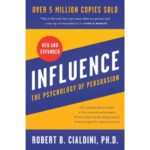LISTEN NOW
Outline: Influence: The Psychology of Persuasion by Robert B. Cialdini
Outline
Expand to Read ...
Introduction: The Psychology of Persuasion
- Central Question: What persuades people to take specific actions?
- Core Concept: Persuasion relies on human fixed-action patterns—mental shortcuts and assumptions that guide everyday decisions.
- Key Issue: These patterns, while useful, are susceptible to manipulation by compliance practitioners (e.g., salespeople, politicians) who exploit them to elicit a “yes.”
Six Principles of Persuasion
- Reciprocity
- Commitment/Consistency
- Social Proof
- Liking
- Authority
- Scarcity
1. Reciprocity
- Definition: The tendency to repay favors or gestures.
- Evolutionary Basis: Fostering reciprocal relationships enhanced survival in early human societies.
- Applications in Persuasion:
- Offering free samples, small gifts, or promotions to create an obligation to reciprocate with a purchase.
- Using the “rejection-then-retreat” strategy: Start with a large request, followed by a smaller, more reasonable one.
- Defense:
- Distinguish genuine acts of kindness from manipulative gestures.
- Recognize when reciprocity is being used to influence your actions unfairly.
2. Commitment/Consistency
- Definition: Once committed to a course of action, people strive for consistency in their beliefs and behaviors.
- Psychological Mechanism:
- After committing, individuals rationalize their actions, aligning their beliefs with their choices.
- Example: Gamblers grow more confident after placing a bet.
- Applications in Persuasion:
- Starting with small commitments (e.g., signing a petition) leads to larger concessions.
- Foot-in-the-door technique: Gradual escalation of requests based on initial compliance.
- Defense:
- Recognize escalating commitments and assess whether they align with your true values.
- Think rationally rather than fabricating justifications for unwanted actions.
3. Social Proof
- Definition: People determine what is correct based on the behavior or opinions of others.
- Psychological Mechanism:
- Herd mentality: Individuals look to the group for cues, especially in uncertain situations.
- Example: Laugh tracks in sitcoms encourage viewers to laugh.
- Applications in Persuasion:
- Advertisements emphasizing popularity (“best-selling,” “fastest-growing”).
- Fake endorsements or staged testimonials (e.g., paid actors posing as satisfied customers).
- Defense:
- Critically evaluate group behavior: Is there a valid reason beyond mere popularity?
- Avoid blindly following others without considering alternative viewpoints.
4. Liking
- Definition: People are more likely to comply with requests from those they know and like.
- Factors That Enhance Liking:
- Attractiveness, similarity, compliments, familiarity.
- Example: Salespeople mentioning mutual acquaintances or sending generic “I like you” notes.
- Applications in Persuasion:
- Using flattery or personal connections to build rapport.
- Leveraging physical attractiveness or friendliness to create positive associations.
- Defense:
- Separate your feelings about the requester from the merits of their proposal.
- Evaluate decisions based on objective criteria rather than personal affinity.
5. Authority
- Definition: People instinctively comply with requests from perceived authority figures.
- Psychological Mechanism:
- Deference to authority supports societal organization but can lead to blind obedience.
- Example: Milgram experiment showing willingness to harm others under authoritative instruction.
- Applications in Persuasion:
- Symbols of authority (e.g., uniforms, titles) used to project credibility.
- Actors posing as experts in advertisements (e.g., “doctors” endorsing products).
- Defense:
- Assess the credentials and relevance of the authority figure.
- Question whether their authority is legitimate in the specific context.
6. Scarcity
- Definition: People value items more when they perceive them as rare or limited.
- Psychological Mechanism:
- Loss aversion: Fear of losing out often outweighs the desire for gain.
- Example: “Limited-time offers” and “while supplies last” marketing tactics.
- Applications in Persuasion:
- Creating artificial scarcity to induce urgency.
- Highlighting competition (e.g., “only a few left”).
- Defense:
- Evaluate whether you truly need or want the item based on its intrinsic value.
- Avoid being swayed by urgency or exclusivity alone.
The Power and Perils of Persuasion
- Strengths: These principles often streamline decision-making and support social harmony.
- Vulnerabilities: When exploited, they can lead to poor choices and manipulation.
- Key Takeaway: Awareness of these tactics empowers you to resist undue influence and make informed decisions.
Conclusion: Mastering Persuasion
- Understanding Compliance Tactics: Recognizing these six principles helps you identify manipulation.
- Resisting Persuasion: Apply critical thinking, challenge assumptions, and make decisions based on logic and values.
- Ethical Persuasion: Leverage these principles responsibly to foster mutual benefit, not exploitation.
This concludes our report on Influence: The Psychology of Persuasion.

 Buy on Amazon
Buy on Amazon